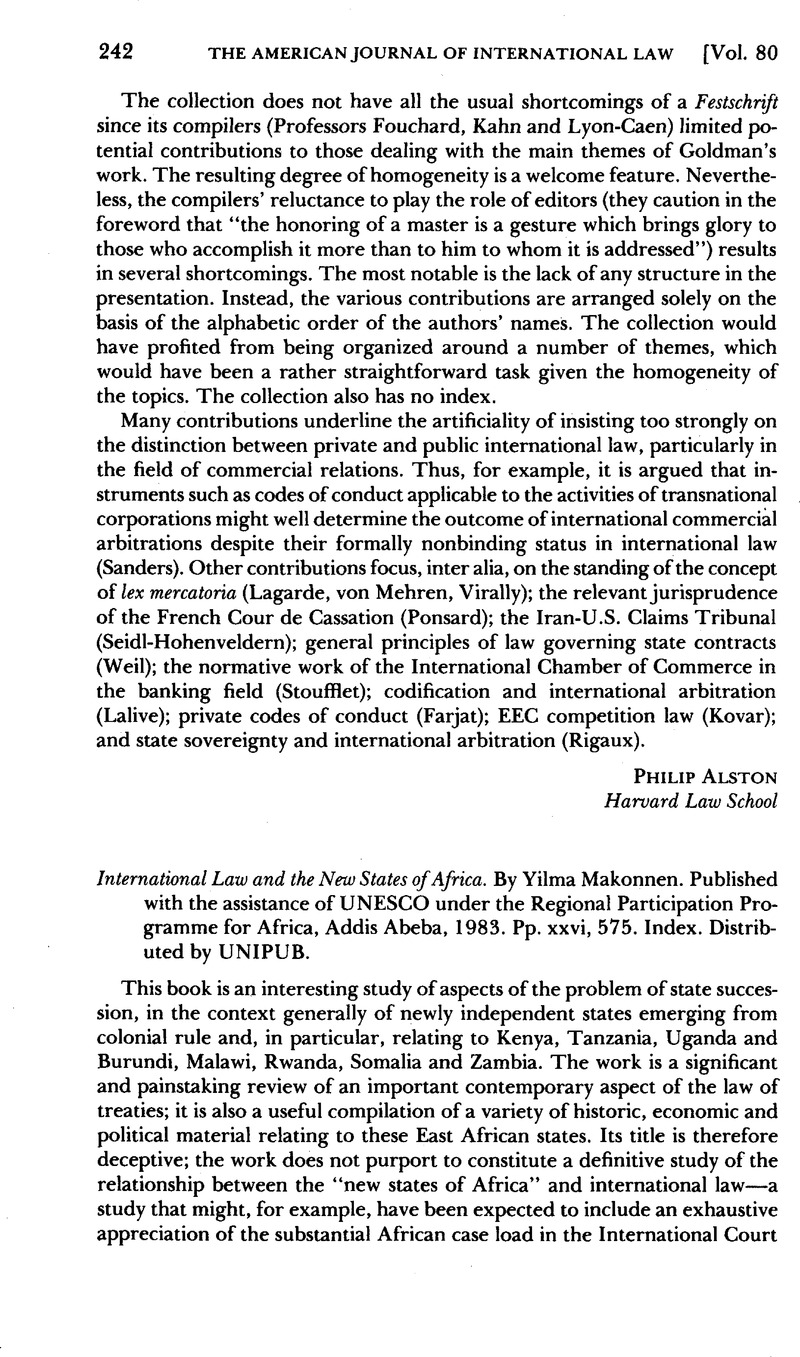No CrossRef data available.
Article contents
International Law and the New States of Africa. By Yilma Makonnen. Published with the assistance of UNESCO under the Regional Participation Programme for Africa, Addis Abeba, 1983. Pp. xxvi, 575. Index. Distributed by UNIPUB.
Published online by Cambridge University Press: 27 February 2017
Abstract

- Type
- Book Reviews and Notes
- Information
- Copyright
- Copyright © American Society of International Law 1986
References
1 Throughout the book, reference is made to “Eastern [or East] Africa states.”
2 Respectively, UN Docs. A/CONF.80/31 (1978) and A/CONF.117/14 (1983).
3 See, e.g., p. 15: “At this stage of the present investigation, there is no doubt that all of the Eastern Africa chiefdoms and kingdoms lost their international legal personalities by outright violations of the terms of the treaties of protection and alliance by the colonial powers.” Thus, the community of nations of the 19th century is characterized as “an exclusively European club” (p. 10); the conclusion is expressed that “the Eastern Africa chiefdoms and kingdoms had been robbed of their sovereignty and international legal personality and reduced to objects of international law” (p. 11); and the observation is made that the existing “rules of international law . . . are not universal in content and application and thus do not incorporate African values, culture or interests” (p. 80).
4 See, e.g., pp. 96–97:
Thus, in conclusion, despite the fact that the Eastern Africa States have accepted some positive rules of general international law upon independence, and although they have also accepted jus cogens as provided for in the Vienna Convention, it is evident that there are no mandatory international legal rules which ipso jure oblige them to accept any category of rules of public international law.
5 D. P. O’Connell receives his fair share of opposition: See, e.g., pp. 71, 139, 227–78, 298 and 372.
6 Although reference is made to the initiative taken by GATT to establish the legitimacy of such new state options and a reflection period for opting in, the author appears—almost defensively— to resist any suggestion that the subject under discussion was not owing to the East African states and to Dr. Nyerere in particular. See pp. 231–32, 491.
This method or device emanated from the general policy of GATT based on expediency rather than on recognition of the international right of a successor State to an option or a period of reflection.. . . Furthermore, there is no evidence to suggest that the Eastern Africa leaders, at the time of the first declaration of the optional doctrine by Tanganyika, were conversant with or were somehow influenced by this GATT method [p. 232].
7 The development of the subject would have benefited from more precise detail, perhaps in the form of interviews or notes verbales, relating to the formulation by these states of East Africa of the position that they could “pick and choose” amongst the preindependence obligations on a modified “clean-slate” theory; the reader is kept in suspense for a number of pages while the discussion refers to the “East African optional doctrine,” without being told quite clearly at that stage what it actually is.
8 Comments such as “[w]hy the colonial power would be interested in the development of the colonial territory if it did not serve its exploitative interests would be beyond anyone’s imagination” (p. 374) do not reassure the objective mind. Nor does it help to refer repeatedly (p. 373) to the “so-called doctrine of unjust enrichment” (emphasis added); to imply that all non-African Kenyans were settlers or aliens, excluding any contemplation that nonindigenous or non-African individuals might validly have acquired Kenyan citizenship (p. 364); or to conclude (without citation or authority) in respect of development expenditures, undertaken as a result of the flotation of what is referred to as the “so-called public debts” of the then colonial territories, that “[available evidence shows clearly that the territories (meaning the indigenous African territories and their economic sectors) did not benefit from such colonial investments, whether in the infrastructure development sector or for social services” (p. 406).
9 The fact that his book intends to deal specifically with the experiences and practice of eight separate states, moreover, naturally leads to the result that the text must periodically traverse or canvass the entire constituency. This is a structural difficulty that creates minor frustration in the reader—together with a sense of anomie—when the state(s) under consideration may not have much to offer in the line of a certain type of experience or in relation to a given specific aspect of the problem.
10 One cannot avoid the impression that the work was perhaps constructed from several different essays or articles: one on the principles of international law and the newly independent states; one on the problems of state succession confronting such states; one on the history and background, pre- and postdecolonization, of the states in question; one on the actual development and application of the “East Africa optional doctrine”; and perhaps several theoretical pieces on questions such as the relationship of jus cogens to state succession.
11 This reviewer, who harbors a doubtless unreasonable prejudice against end notes, would have much preferred a different approach to notation: it is interesting how, when the discourse of the book becomes somewhat stolidly abstract, the meaty and concrete data are to be found in an end note. One suggests that if this worthy study undergoes a new edition, consideration be given to incorporating many of the quotations and comments now residing in the end notes into the actual text of the work itself; leaving references only for the notes; and moving them, in any event, to the foot of the relevant pages.


